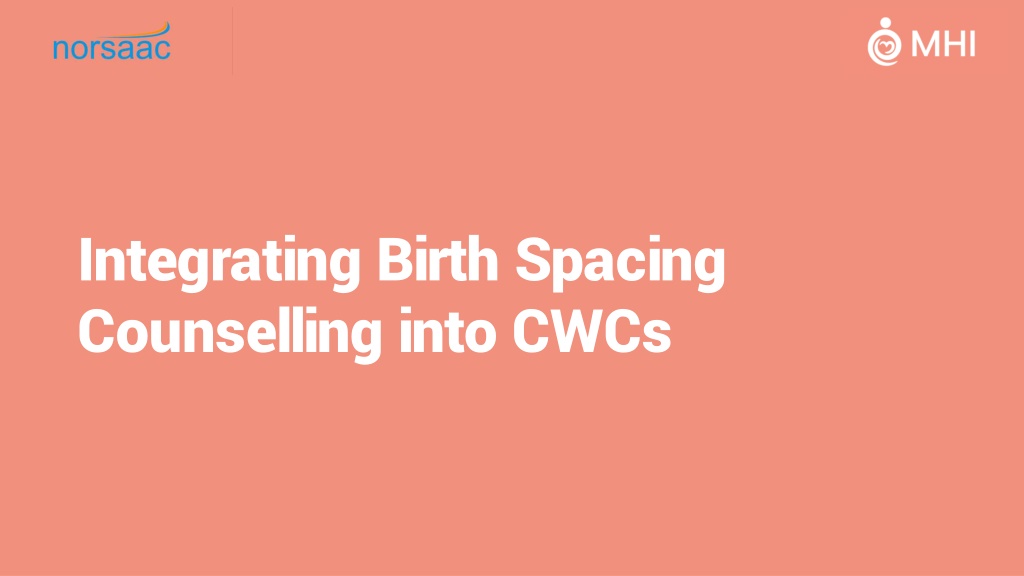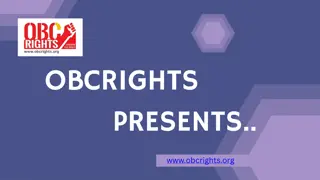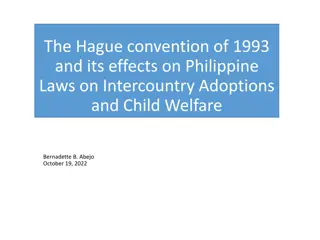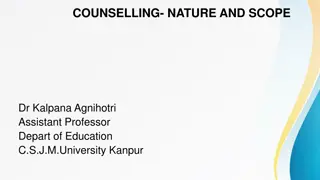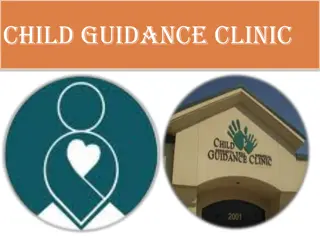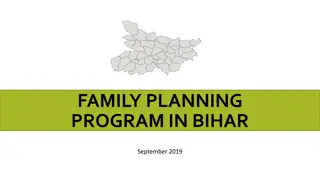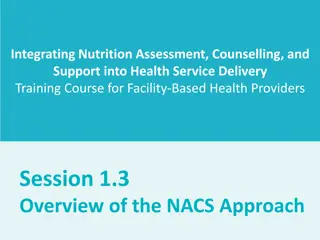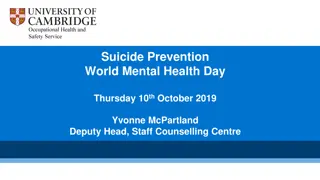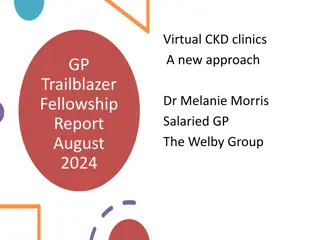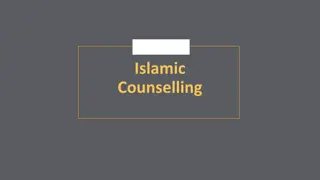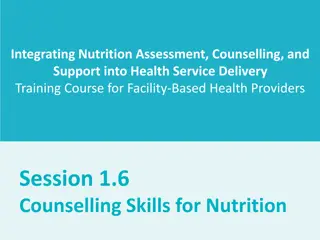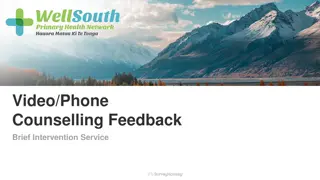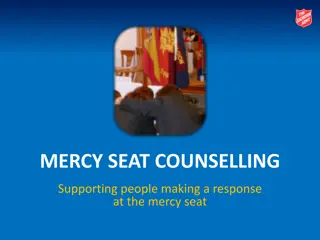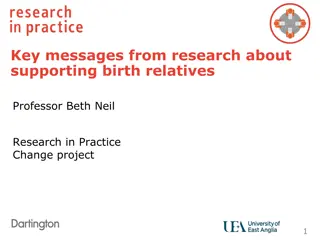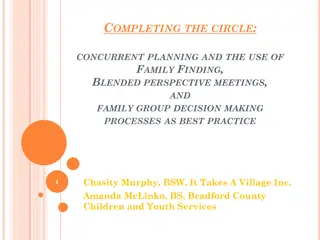Integrating Birth Spacing Counselling into Child Welfare Clinics
This project focuses on integrating birth spacing counselling into Child Welfare Clinics (CWCs) to provide essential family planning guidance to mothers. The initiative emphasizes the benefits of birth spacing, changes in care practices, and the importance of one-on-one counselling for women's reproductive health decisions. The approach aims to increase contraceptive uptake and empower women to make informed choices independently. Through practical sessions and tools like flipcharts and counselling cards, providers can offer personalized support to mothers attending CWCs.
Download Presentation

Please find below an Image/Link to download the presentation.
The content on the website is provided AS IS for your information and personal use only. It may not be sold, licensed, or shared on other websites without obtaining consent from the author. Download presentation by click this link. If you encounter any issues during the download, it is possible that the publisher has removed the file from their server.
E N D
Presentation Transcript
Integrating Birth Spacing Counselling into CWCs
Overview Guidelines Respect one another; keep an open mind; no answers are wrong; phones should be on silent Structure Morning -explanation of counselling materials, model of care, and their value Afternoon -practice using the materials followed by a skills assessment and post-test
Changes to Care Key change: short one-to-one family planning discussion with every woman while their child is vaccinated Today you will learn how to use new tools that you will be using every day in your work There is a new flipchart for the group talk You have been given a CWC Counselling Card to use for giving brief family planning guidance to every client whose child is receiving an immunisation
Benefits of Integrating Family Planning into CWC Opportunity to reach most mothers, due to high attendance at CWC Helpful timing, as many women may be moving back to their husband s house It s particularly risky to get pregnant soon after a birth Women trust the information that they receive from providers like you
Why one to one counselling? Women consistently highlight concern around side effects, such as bleeding, as barriers to taking up a method Some of these side effects are uncomfortable to raise in front of others during a group talk -one to one counselling is necessary so clients can raise their personal concerns One to one counselling allows clients to use their right to decide on a method independently of their husband, mother-in-law, or community pressure
Evidence for one to one counselling 15% increase in contraceptive uptake Dulli et al. 2016 -Randomised Control Trial 2-3 minute 1:1 counselling during vaccination, with a group talk Even brief counselling on family planning during busy child welfare clinics can lead to meaningful increases in contraceptive uptake
Why this work is needed Only 12% of married or unmarried but sexually active women are using a method in the Northern Region, less than half of all the other regions. 66% of these women had used family planning previously We interviewed over 150 women in northern Ghana and found that many women: Want more information about birth spacing methods Have health concerns about birth spacing methods
Postpartum family planning is a priority of the Ghana Health Service s Family Health Division We are all here to work together to help the Northern Region be a leader in developing and implementing this work Working with the Northern Regional Health Directorate through this program to make your hospitals model facilities for this work
Please use what you learn today We expect to see you using the tools we give you today immediately We will be following-up in one week s time with the supervisors at your facility We will visit your facilities in the next two weeks to check the tools are being used and understand any challenges you are facing In four weeks we will be surveying clients to see if you are using the tools we are giving you today
Accountability External follow-up surveys will be conducted in one month to check whether care is occurring according to the training Random surveying of clients via phone to check whether care is occurring Brief knowledge and monitoring check-ins through WhatsApp in the weeks following the training
Reach out to your programme champion! Each hospital has one programme champion -a team member who has been asked to additional work to support the program They are there to support you if you have questions or concerns about the tools and the approach that you are trained in today Can the programme champions for each facility please raise their hands?
Using the Birth Spacing Cards Use with every mother while their baby is being vaccinated Should only take ~1 minute Show the card to the client, and point to methods as you speak about them Methods are divided into four categories, with an explanation of each category on the back of the card
Offer Referral Cards to the Family Planning Unit Many women want to use a method but don t due to the cost or difficulty of accessing a location where they can get it Important to inform women that they can get a method on the same day if they wish Offer a referral card to every woman you speak with at CWC
We are not expecting you to offer full family planning counselling to each client Take 2 minutes with every client whose child is vaccinated to discuss family planning using the Birth Spacing Card Then offer a referral card to visit the family planning unit
Pair Activity: Birth Spacing and Referral Cards Pair up and practise asking the questions on the birth spacing cards, giving the information and offering the referral card with one person as the provider and the other as the client. Provide feedback and then switch roles. Time: 20 minutes
Troubleshooting challenges Limited time to share messaging Include messaging, even if it is brief At the busiest times, only offer a referral card Clients are not interested Understand why they are not interested Ask if they want a referral to discuss their concerns in more depth
Time for a break (if not yet taken)
Group Talks Provide a brief family planning group talk at every CWC session Use the flipchart we have provided to give short talks when busy or alongside other health topics Use the Ghana Health Service family planning flipchart to give a longer talk when there is time
Why use this flipchart? Emphasis is on the main counselling messages We have designed this flipchart to be much shorter and easier to use than the standard family planning flipchart Brief version of group talk is only 5 minutes long so it can even be given multiple times, early in the morning and then later for clients who arrive after the first talk
Group Talk Structure Structured around method preferences Based on research: Concern about side effects is the primary reason for non-use of methods These 4 categories align with most common reasons for method choice Methods are not one-size-fits all Empower women with correct information so they can pick a method that s right for them
Method Types Fertility concerns are a key barrier to contraceptive use Knowing that many methods offer a quick return to fertility likely increases uptake Some women prefer methods that can be concealed from others
Method Types, continued Key reason why people discontinue methods Important for women to be aware that some methods have limited or no bleeding effects Some women prefer methods that are convenient and easy to use
Methods Information Booklet In-depth information on methods -how they work; what side effects there are; how to manage them Keep it handy for questions during group talks and one-to-one engagements
Group Talk Demonstration
Pair Activity: Group Talk Pair up and practise giving the group talk, with one person as the provider and the other as the audience of clients. Provide feedback and then switch roles. Time: 1 hour
Group Talk Debrief Questions? Particularly effective strategies?
Skills Test Pair up and take turns demonstrating how to counsel using the birth spacing and referral cards. Next, do the same with the group talk. Make sure to fill out the assessment! Open SurveyCTO: Collect app Select Fill Blank Form Select Skills Assessment -CWC Time: 1 hour
Recap We hope that you use the new tools and find it helpful for speaking with clients about safe birth spacing Start using the new approach straight away Programme champions will be there to help you if you have any questions about the new approach
Please use what you have learnt today Bring the materials back to the facility with you! We expect to see you using the flipchart in group talks and the birth spacing & referral cards from now We will be following-up in one week s time with the supervisors and program champions at your facility In four weeks we will be surveying clients to see if you are using the materials
Recap: Changes to Care Improved group talk that you should follow from now on when doing group talks in the waiting room Brief individual messaging using birth spacing cards during every immunisation New referrals system to the family planning unit, you should offer every client a referral card
Why are we here? With your help, women will have accurate information to make informed decisions Promoting healthy families and communities!
Open SurveyCTO: Collect app Select Fill Blank Form Select and fill out Provider Knowledge Post-Test Select and fill out Training Feedback Make sure to select Save Form and Exit at the end Post-test and feedback
